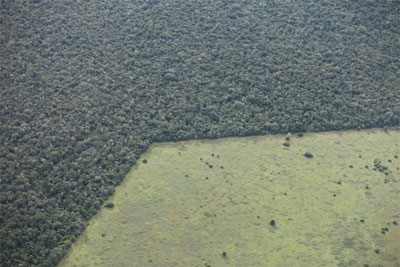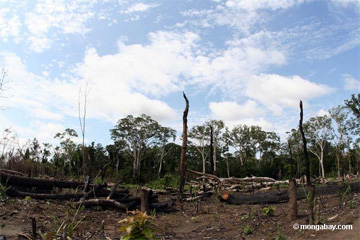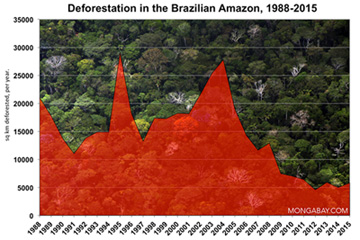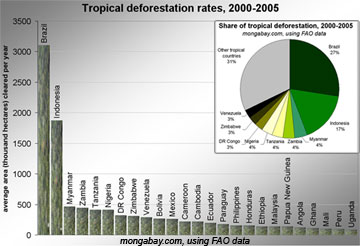Brazil has its own designs for REDD
|
|
Accounting for roughly half of tropical deforestation between 2000 and 2005, Brazil is the most important supply-side player when it comes to developing a climate framework that includes reducing emissions from deforestation and forest degradation (REDD). But Brazil’s position on REDD contrasts with proposals put forth by other tropical forest countries, including the Coalition for Rainforest Nations, a negotiating block of 15 countries. Instead of advocating a market-based approach to REDD, where credits generated from forest conservation would be traded between countries, Brazil is calling for a giant fund financed with donations from industrialized nations. Contributors would not be eligible for carbon credits that could be used to meet emission reduction obligations under a binding climate treaty.
 The concept of REDD is straightforward: tropical forests store roughly 25 percent of the planet’s terrestrial carbon, more than 300 billion tons. When forests are cut—their vegetation burned and timber converted into wood products—much of this carbon is released in the atmosphere as carbon dioxide. The clearing of 50,000 square miles of tropical forest annually accounts for roughly 20 percent of global emissions from human activities—a share larger than all the world’s planes, ships, cars, and trucks combined. In other words, despite the attention given to the fuel efficiency of cars and the number of flights taken by celebrities, parking all the world’s jets and cars still wouldn’t offset the annual emissions from global deforestation. But reducing deforestation is no simple effort. Forests are being destroyed as a consequence of global economic forces—demand for timber, pulpwood, beef, soybeans, and palm oil—as well as subsistence farming. Slowing or eliminating deforestation means addressing these underlying drivers by making forests valuable as living entities, rather than solely for what can be produced when they’re cut. And the issue goes beyond economics. Good governance, including law enforcement, recognition of land rights, and fair distribution of benefits, is the issue that will make or break REDD. |
Brazil’s current stance is understandable—the country is hesitant to sign up for a deal that could potentially compromise its rise to being a global economic superpower. Further, like other emerging economies, Brazil feels that because climate change is a problem created by rich countries, the result of 150 years’ worth of emissions, it is mostly their responsibility to address the problem. In other words, Brazil is not eager to let the biggest historical polluters—the United States and Europe—off the hook without reducing their own emissions.
“Brazil is not interested in giving industrialized countries cheap carbon credits from protecting the Amazon if they are not going to stop building coal-fired power plants,” said William Boyd, a professor of law at the University of Colorado who has worked extensively on REDD policy issues.
However Brazil is well aware of the projected impacts of climate change. Scientists expect climate change to increase rainfall in the heart of the Amazon, boosting the risk of flooding. Paradoxically, the south will suffer from increased incidence of drought, which could devastate its agricultural heartland, undermine its ability to supply itself with energy (biofuels and hydroelectric power), and turn vast areas of rainforest and savanna into a tinderbox. Brazil has already had a taste of this future. A severe drought in 2005—triggered by above normal temperatures in the tropical Atlantic—spurred widespread fires, reduced electricity generation from hydro plants, and turned rivers into muddy ponds, isolating communities and bringing river-based commerce to a standstill. Meanwhile last month, near record floods killed hundreds and left more than half a million homeless.
Acknowledging these threats to its economy and anticipating some form of climate agreement in coming years, Brazil last year announced a plan to reduce deforestation by 70 percent from a 1996-2005 baseline, a move that would cut emissions from deforestation—the source of roughly 80 percent of the country’s emissions—by 4.8 billion tons between 2006 and 2017, an amount greater than the annual emissions of Canada and the E.U. combined. To pay for the program, President Luiz Inacio Lula da Silva created the Amazon Fund, which he seeks to finance to the tune of $21 billion through donations from industrialized countries, individuals, and private companies. But under the current design, the scheme would be somewhat akin to development aid rather than be part of a market with fungible carbon offsets.
 Brazil’s proposed targets for reducing deforestation:
|
Though the details for how the Amazon Fund will actually reduce deforestation are somewhat abstract, the government of Norway has already agreed to provide up to $1 billion—contingent on Brazil’s success in reducing deforestation. But so far no other countries have put up money for the fund.
Brenda Brito, executive director at Imazon, a Brazilian research institute, who is drafting a resolution for the Forum for a Sustainable Amazon to present at upcoming climate negotiations, suggests that donations may not be forthcoming because countries are waiting to see what happens at upcoming U.N. climate talks in Copenhagen this December.
“I think the fund is a good initiative to demonstrate that it is possible to have a national controlled mechanism to concentrate international resources for REDD, but at the same time it’s not clear if the fund will be compatible with a possible regime of REDD to be created in Copenhagen,” she told mongabay.com. “For example, if there’s a decision to create an international fund for REDD, would other countries still make donations to the Amazon fund? I think that such uncertainty may be affecting other possible donations to the fund and that the decisions in December will be fundamental to determine the future of the Amazon Fund regarding other countries’ willingness to make donations.”
  Over the past decade more than 10 million hectares – an area about the size of Iceland – was cleared for cattle ranching as Brazil rose to become the world’s largest exporter of beef. Now the government aims to double the country’s share of the beef export market to 60% by 2018 through low interest loans, infrastructure expansion, and other incentives for producers. Most of this expansion is expected to occur in the Amazon were land is cheap and available. 70 percent of the country’s herd expansion between 2002 and 2006 occurred in the region. |
Others are skeptical that a fund-based approach will generate enough money (variously estimated at $15-40 billion per year) to provide incentives to effectively reduce deforestation on a global scale. After all, returns from carbon conservation will have to compete with the drivers of deforestation including cattle ranching, industrial agricultural, logging, and plantation forestry.
Sergio Abranches, a Brazilian environmental journalist and radio commentator, suggests a third possibility for the lack of support: concerns over accountability and governance. There are questions whether a scheme to reduce deforestation can be implemented by Brazil’s massive development bank, BNDES, which is better known for funding projects that drive forest clearing than for its environmental record. Some observers question whether Brazil can actually control deforestation, noting that recent deforestation in the Brazilian Amazon more closely reflects economic trends than government enforcement.
There are also worries that Brazil will use the Amazon Fund as to block other, potentially more effective, forest conservation proposals.
“The fund will be used by the Brazilian government to oppose better structured REDD proposals,” Abranches told mongabay.com. “There is no model behind it, it is being structured on the fly. There is no clear policy regarding the use of the money it could raise.”
“I fear it will benefit companies and projects scarcely related to forest conservation and sustainable use, over local communities and investment in science and technology to develop a new and advanced economic model for the Amazon. It could, for instance, finance cattle wholesalers and exporters (the same that appear on Greenpeace’s recent analysis of cattle ranching and deforestation) to improve their activities, instead of funding alternative economic ventures that could become an alternative to cattle ranching in the Amazon.”
“If the Brazilian government continues to oppose the inclusion of forests/REDD to the climate deal it is very likely that the most important environmental organizations, engaged corporate representatives and several Amazon governors will publicly oppose the government’s position.”
Nevertheless Brazil’s commitment to reducing deforestation is a monumental one with national credibility and substantial sums of money tied to its outcome.
 Industry is now a greater driver of deforestation than subsistence activities. |
Stephan Schwartzman, co-director of the International Program at the Environmental Defense Fund who helped pioneer the concept of national baselines (essentially emissions caps) for REDD under a climate framework, says it is important to put the challenge of Brazil’s undertaking into context.
“The reason Lula was willing to stand up in front of the international community and commit to reducing Brazil’s national deforestation 70 percent over the next decade was that he believes Brazil can reduce its deforestation rate. He and Environment Minister Carlos Minc have real grounds for believing that. Their government created an area of new protected areas the size of France in five years, between 2003 and 2008, mostly right in the middle of the expanding agricultural frontier—not in end-off-the-world regions where no one cares about the land.”
“The Amazon Fund is an important and innovative step. It is the first time that a major tropical country has set up any kind of a mechanism to try to create a means to compensate a whole array of actors that will have to benefit if a national-level program to reduce deforestation is going to work. I don’t think we can expect that there will be no glitches. If you take a look at it from a historical perspective — there have been a lot of agricultural frontiers over the course of the history of this planet. All of Western Europe was forest at one time. All of the eastern United States was native forest at one time. There’s never been an example of a nation undertaking to regulate and control the ecological and environmental effects of frontier expansion. This is new territory—it’s not like there’s a recipe in a cookbook for this. People who are concerned with the Amazon Fund need to help it deliver on its promise.”
 Since 2003 Brazil has set aside 523,592 square kilometers of protected areas, accounting for 74 percent of the total land area protected worldwide during that period. |
Still, within Brazil there is lively debate over the proposal, especially between the federal government and state governments. The state of Amazonas—home to 1.57 million square kilometers of rainforest, an area larger than Mongolia or the state of Alaska—is far out in front of the rest of Brazil when it comes to developing carbon projects and wants to be paid directly, via a market mechanism, for its efforts. Amazonas fears that money directed through the central government in Brasilia will be siphoned off by the bureaucracy, reducing the viability of its innovative carbon finance programs. These are embodied in the Juma Sustainable Development Reserve Project and the Bolsa Floresta payments for ecosystem services initiative, which compensate rural populations for using forests sustainably. Juma, the first forest carbon project in the world to attain the Climate, Community and Biodiversity Alliance’s Gold Standard (a certification standard) for its safeguards, is paying 6,000 families who voluntarily agree to limit forest cutting. The project has raised per capita income by 30 percent among members and is expected to reduce emissions in a forest area, which would likely otherwise be deforested by 190 million tons of carbon dioxide by 2050.
 Rainforest and soy in the Brazilian Amazon |
Virgilio Viana, the secretary of environment for Amazonas who helped design and implement the Bolsa Floresta program, argues that project-level or sub-national approaches are currently more appropriate for direct market compensation than a national fund. For example, Bolsa Floresta and Juma have received funding from the private sector: Bradeso, a Brazilian bank; the Marriott hotel chain, which solicits contributions from guests; and other companies. Viana believes that unlike other states, Amazonas projects are ready for market mechanisms now.
These project-level versus national-level concerns are shared among indigenous communities that are exploring the possibilities of REDD. Indigenous groups are also worried that because they have historically served as guardians of forests—deforestation rates in indigenous territories are lower than in parks and unprotected areas—they won’t qualify for REDD payments, which reward activities that reduce forest clearing relative to a baseline of past deforestation.
“REDD should enhance recognition that indigenous people have maintained the state of their forests, not penalize them for this stewardship,” said Vasco van Roosmalen, director of the Amazon Conservation Team-Brazil, an NGO that has helped the Surui tribe develop carbon project in the state of Acre.
Land rights too are an issue. While vast areas have been demarcated for indigenous use, these groups don’t have legal title to the land, which still belongs to the government. But a recent analysis of Brazilian law and legal precedent by Baker McKenzie concluded that indigenous people have the right to payments for forest carbon in their territories, opening the door for indigenous carbon projects, provided these groups can hold on to their lands. Some fear the prospect of carbon payments will increase land speculation, leading to greater conflict over forests.
Paulo Moutinho, a forest policy expert at the Instituto de Pesquisa Ambiental da Amazônia (IPAM), a Brazilian NGO, says that structuring the Amazon Fund under rights principles that guarantee an equitable distribution of benefits among important stakeholders will be key to addressing some of these concerns and making the Fund an effective means for reducing deforestation.
“There are many challenges involving the Fund, but it was built with a large participation of Brazilian society,” Moutinho told mongabay. “Every sector of this society is now represented by the Fund’s organizational committee.”
Moutinho still believes that the Fund will need to be open to some form of carbon market to be effective.
Consensus building

|
Amazon states seem to be coming around to the idea that they need to set aside their differences to form a consensus on how to implement and finance activities to reduce deforestation. In April governors of major Amazon states signed the Cuiaba Declaration, which commits them to forming a consensus ahead of the climate meeting in Copenhagen. The states come from a position of strength—together they account for more than one-third of tropical deforestation.
But while Brazil will present a unified front in Copenhagen, it is unlikely that its insistence on a pure fund-based mechanism is set in stone. The country is well aware that a market-based system may be the most lucrative way for it to capitalize on the potential value of its vast natural assets including forest carbon, water, and biodiversity. Consultancy McKinsey & Co. estimates that under a relatively conservative scenario Brazil could rake in 30 billion per year in payments for ecosystem services by 2030 making it “the Saudi Arabia of ecosystem services.”
Related
How to save the Amazon rainforest
(01/04/2009) Environmentalists have long voiced concern over the vanishing Amazon rainforest, but they haven’t been particularly effective at slowing forest loss. In fact, despite the hundreds of millions of dollars in donor funds that have flowed into the region since 2000 and the establishment of more than 100 million hectares of protected areas since 2002, average annual deforestation rates have increased since the 1990s, peaking at 73,785 square kilometers (28,488 square miles) of forest loss between 2002 and 2004. With land prices fast appreciating, cattle ranching and industrial soy farms expanding, and billions of dollars’ worth of new infrastructure projects in the works, development pressure on the Amazon is expected to accelerate. Given these trends, it is apparent that conservation efforts alone will not determine the fate of the Amazon or other rainforests. Some argue that market measures, which value forests for the ecosystem services they provide as well as reward developers for environmental performance, will be the key to saving the Amazon from large-scale destruction. In the end it may be the very markets currently driving deforestation that save forests.
Brazil’s ecosystem payments system offers clues for REDD implementation
(02/25/2009) Brazil’s existing system for environmental services payments could offer insight for implementing carbon-credits-for-forest-conservation (REDD) initiatives in the Amazon rainforest, argues a London School of Economics researcher in a new paper published in Philosophical Transactions of the Royal Society B.
